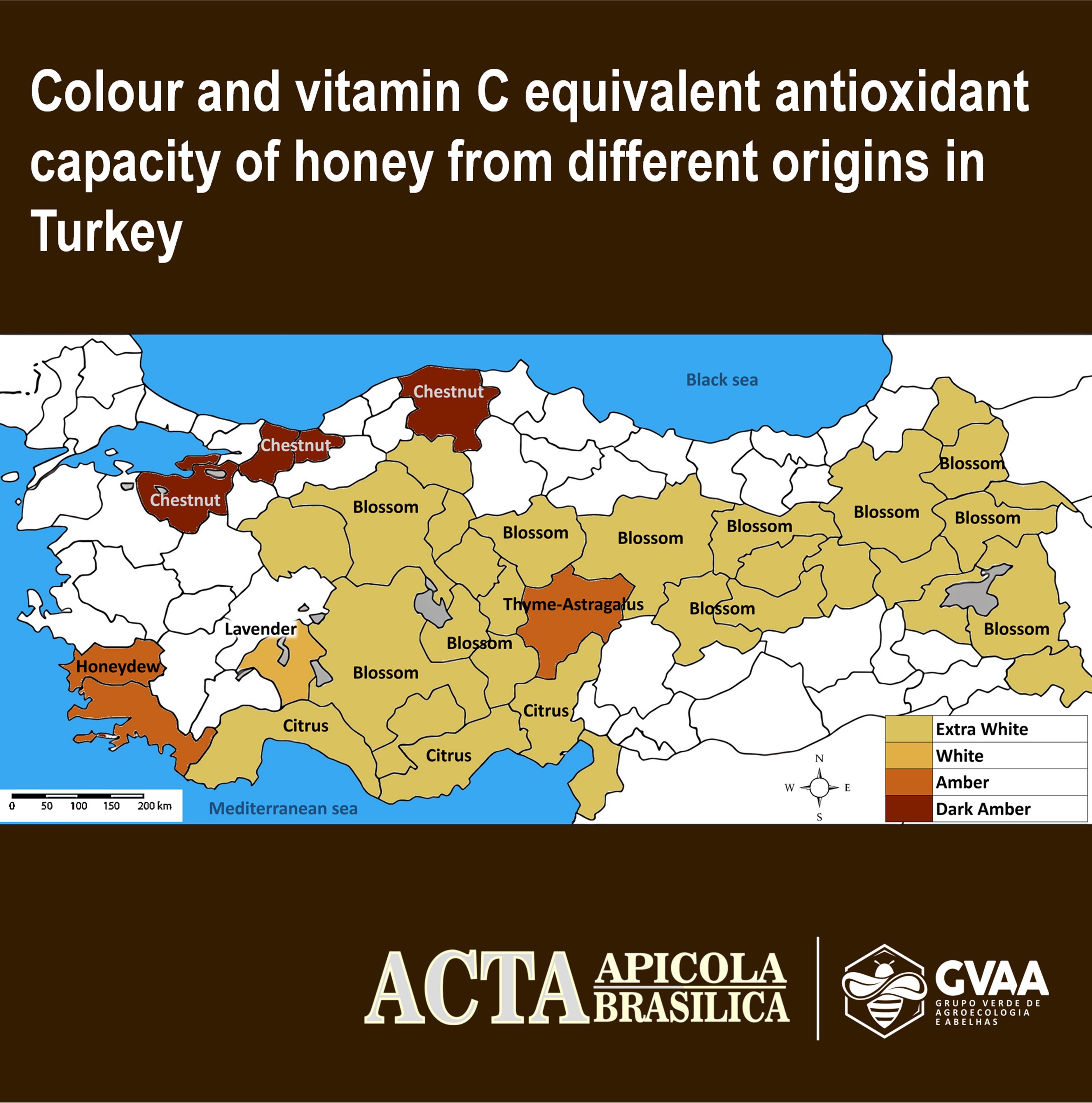Colour and vitamin C equivalent antioxidant capacity of honey from different origins in Turkey
DOI:
https://doi.org/10.18378/aab.10.9649Keywords:
Ascorbic acid, Pfund Scale, SpectrophotometerAbstract
The nutritional content, antioxidant capacity and sensory characteristic such as colour vary related to botanical and geographical origins. The study was aim to investigate the spectrophotometric classification of honey colour by Pfund scale and the vitamin C equivalent antioxidant capacity (VCEAC) expressed as l-ascorbic acid equivalent by MTT assay. Eight honey samples originating from different geographical areas of Turkey were supplied and coded. The colour of the samples was determined as extra white (blossom-multifloral and citrus), white (blossom-multifloral and lavender), amber (thyme-Astragalus and honeydews) and dark amber (chestnut). The highest VCEAC was statistically measured in the honeydews and citrus honey, as the lowest was in the blossom and chestnut honey. And, there was no significant interaction between the colour score and the VCEAC of the honey. In conclusion, the honey from different botanical and geographical origins in Turkey showed the antioxidant capacity independently of their colour. The results needed further studies to investigate the floral diversity and phytochemical contents which influence the colour and antioxidant capacity of honey.
Downloads
References
ALBU, A.; RADU-RUSU, C. G.; POP, I. M.; FRUNZA, G.; NACU, G. Quality assessment of raw honey issued from Eastern Romania. Agriculture (Switzerland), v.11, 2021. https://doi.org/10.3390/agriculture11030247 DOI: https://doi.org/10.3390/agriculture11030247
ALYGIZOU, A.; GRIGORAKIS, S.; GOTSIOU, P.; LOUPASSAKI, S.; CALOKERINOS, A. C. Quantification of Hydrogen Peroxide in Cretan Honey and Correlation with Physicochemical Parameters. Journal of Analytical Methods in Chemistry, v.2021, 2021. https://doi.org/10.1155/2021/5554305 DOI: https://doi.org/10.1155/2021/5554305
ATTANZIO, A.; TESORIERE, L.; ALLEGRA, M.; LIVREA, M. A. Monofloral honeys by Sicilian black honeybee (Apis mellifera ssp. sicula) have high reducing power and antioxidant capacity. Heliyon, v.2, 2016. https://doi.org/10.1016/j.heliyon.2016.e00193 DOI: https://doi.org/10.1016/j.heliyon.2016.e00193
BILUCA, F. C.; BRAGHINI, F.; GONZAGA, L. V.; COSTA, A. C. O.; FETT, R. Physicochemical profiles, minerals and bioactive compounds of stingless bee honey (Meliponinae). Journal of Food Composition and Analysis, v.50, p.61–69, 2016. https://doi.org/10.1016/j.jfca.2016.05.007 DOI: https://doi.org/10.1016/j.jfca.2016.05.007
BILUCA, F. C.; DA SILVA, B.; CAON, T.; MOHR, E. T. B.; VIEIRA, G. N.; GONZAGA, L. V.; VITALI, L.; MICKE, G.; FETT, R.; DALMARCO, E. M.; COSTA, A. C. O. Investigation of phenolic compounds, antioxidant and anti-inflammatory activities in stingless bee honey (Meliponinae). Food Research International, v.129, p.108756, 2020. https://doi.org/10.1016/j.foodres.2019.108756 DOI: https://doi.org/10.1016/j.foodres.2019.108756
BODOR, Z.; BENEDEK, C. Colour of honey: can we trust the Pfund scale ? – An alternative graphical tool covering the whole visible spectra, v.149, 2021. https://doi.org/10.1016/j.lwt.2021.111859 DOI: https://doi.org/10.1016/j.lwt.2021.111859
EL SOHAIMY, S. A.; MASRY, S. H. D.; SHEHATA, M. G. Physicochemical characteristics of honey from different origins. Annals of Agricultural Sciences, v.60, p.279–287, 2015. https://doi.org/10.1016/j.aoas.2015.10.015 DOI: https://doi.org/10.1016/j.aoas.2015.10.015
ESCUREDO, O.; MÍGUEZ, M.; FERNÁNDEZ-GONZÁLEZ, M.; CARMEN SEIJO, M. Nutritional value and antioxidant activity of honeys produced in a European Atlantic area. Food Chemistry, v.138, p.851–856, 2013. https://doi.org/10.1016/j.foodchem.2012.11.015 DOI: https://doi.org/10.1016/j.foodchem.2012.11.015
FERREIRA, I. C. F. R.; AIRES, E.; BARREIRA, J. C. M.; ESTEVINHO, L. M. Antioxidant activity of Portuguese honey samples : Different contributions of the entire honey and phenolic extract. Food Chemistry, v.114, p.1438–1443, 2009. https://doi.org/10.1016/j.foodchem.2008.11.028 DOI: https://doi.org/10.1016/j.foodchem.2008.11.028
KIVRAK, Ş.; KIVRAK, İ.; KARABABA, E. Characterization of turkish honeys regarding of physicochemical properties, and their adulteration analysis. Food Science and Technology (Brazil), v.37, p.80–89, 2017. https://doi.org/10.1590/1678-457X.07916 DOI: https://doi.org/10.1590/1678-457x.07916
LIU, Y.; NAIR, M. G. An efficient and economical MTT assay for determining the antioxidant activity of plant natural product extracts and pure compounds. Journal of Natural Products, v.73, p.1193–1195, 2010. https://doi.org/10.1021/np1000945 DOI: https://doi.org/10.1021/np1000945
MALDONADO, L. M.; MARCINKEVICIUS, K.; SALOMÓN, V.; SÁNCHEZ, A. C.; ÁLVAREZ, A.; LUPO, L.; BEDASCARRASBURE, E. Physicochemical and melissopalynological profiles of Citrus limon honey from Tucumán-Argentina. Hesperidin as a suitable marker of floral origin. Revista de Investigaciones Agropecuarias, v.47, p.315–324, 2021.
MARTINELLO, M.; MUTINELLI, F. Antioxidant activity in bee products: A review. Antioxidants, v.10, p.1–42, 2021. https://doi.org/10.3390/antiox10010071 DOI: https://doi.org/10.3390/antiox10010071
MURAINA, I. A.; SULEIMAN, M. M.; ELOFF, J. N. Can MTT be used to quantify the antioxidant activity of plant extracts? Phytomedicine, v.16, p.665–668, 2009. https://doi.org/10.1016/j.phymed.2008.11.005 DOI: https://doi.org/10.1016/j.phymed.2008.11.005
PUŚCION-JAKUBIK, A.; KARPIŃSKA, E.; MOSKWA, J.; SOCHA, K. Content of Phenolic Acids as a Marker of Polish Honey Varieties and Relationship with Selected Honey-Quality-Influencing Variables, 2022. https://doi.org/10.3390/antiox11071312 DOI: https://doi.org/10.3390/antiox11071312
RATIU, I. A.; AL-SUOD, H.; BUKOWSKA, M.; LIGOR, M.; BUSZEWSKI, B. Correlation study of honey regarding their physicochemical properties and sugars and cyclitols content. Molecules, v.25, 2020. https://doi.org/10.3390/molecules25010034 DOI: https://doi.org/10.3390/molecules25010034
SÁNCHEZ-MARTÍN, V.; MORALES, P.; GONZÁLEZ-PORTO, A. V.; IRIONDO-DEHOND, A.; LÓPEZ-PARRA, M. B.; DEL CASTILLO, M. D.; HOSPITAL, X. F.; FERNÁNDEZ, M.; HIERRO, E.; HAZA, A. I. Enhancement of the Antioxidant Capacity of Thyme and Chestnut Honey by Addition of Bee Products. Foods, v.11, 2022. https://doi.org/10.3390/foods11193118 DOI: https://doi.org/10.3390/foods11193118
SILICI, S.; SAGDIC, O.; EKICI, L. Total phenolic content, antiradical, antioxidant and antimicrobial activities of Rhododendron honeys. Food Chemistry, v.121, p.238–243, 2010. https://doi.org/10.1016/j.foodchem.2009.11.078 DOI: https://doi.org/10.1016/j.foodchem.2009.11.078
TSIGOURI, A.; PASSALOGLOU-KATRALI, M.; SABATAKOU, O. Palynological characteristics of different unifloral honeys from Greece. Grana, v.43, p.122–128, 2004. https://doi.org/10.1080/00173130310017643 DOI: https://doi.org/10.1080/00173130310017643

Downloads
Published
How to Cite
Issue
Section
License
Copyright (c) 2022 Sinem Bahar et al.

This work is licensed under a Creative Commons Attribution 4.0 International License.












